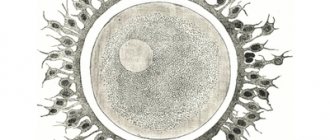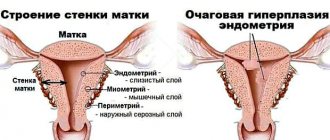Pregnancy and the birth of a child are long-awaited events in the lives of many families. It is the time of fertilization of the egg that is considered the moment of the birth of a new life, but in order for this to happen, several events must take place. In addition, fertilization of the egg is only the first step towards pregnancy, because the zygote must undergo a series of transformations, successfully implant in the endometrium and develop.
Fertilization of an egg is a complex process of fusion of germ cells, depending on many external and internal factors. Before fertilization of the egg occurs, a number of other mechanisms take place: the formation of reproductive gametes, ovulation, ejaculation, the process of sperm passing into the uterine cavity and the dissolution of the protective membranes of the oocyte.
The process of fertilization of an egg is an amazing biological mechanism, each stage of which is designed to ensure the appearance of healthy and full-fledged offspring. In order for a fertilized egg to be able to transform into an embryo and continue further development, it is necessary to monitor your health throughout your life. This is especially true for women, because in addition to fertilization of the egg, optimal conditions for the growth and development of the fetus must be formed in the uterus. Therefore, pregnancy planning plays an important role in modern society. You can undergo a full examination, receive the necessary information and advice, as well as therapeutic measures at the IVF Center clinic in Volgograd.
Ovulation
Many people are interested in how long it takes for an egg to be fertilized. But it is worth noting that the process is impossible without several important previous changes in the body, including ovulation.
Ovulation is the release of an egg from the follicle into the abdominal cavity. Every month, each woman matures 1 full-fledged egg (rarely several, which leads to multiple pregnancies), although several cells begin dividing at the same time. The process of maturation and release of the egg is regulated by hormones.
As a rule, ovulation occurs in the middle of the menstrual cycle and is preceded by an increase in basal temperature and an increase in LH levels in the blood. For fertilization of a woman's egg to occur, the reproductive gamete must pass from the ovaries into the fallopian tube. This is done due to the preliminary receipt of information about the location of future ovulation; as a result, the villi of the fallopian tubes envelop the ovary and constantly read signals from its surface; at the moment the egg is released, they immediately capture it inside so that it is not lost in the abdominal cavity.
But how long does it take for an egg to fertilize from the moment it is released? In principle, fertilization of an egg is a dynamic process, but it is only possible within 24 hours after ovulation; if the egg does not meet a sperm, it will die and be released along with menstrual flow.
Menstrual cycle
Conceiving a child can occur on certain days of the monthly cycle, which begins on the first day of menstruation. Over the course of a woman's life, the length of her menstrual cycle may change. Irregular periods are often observed during puberty.
The cycle, on average, lasts 28 days (different women have from 25 to 35). There are often cases when there is an irregularity of the cycle: in each month the number of days is different.
Where and how does egg fertilization occur?
Fertilization of a woman's egg in most cases occurs in the fallopian tubes. The reproductive gamete does not have its own villi and is not able to move independently, but due to periodic contractions of the fallopian tubes, it moves towards the uterine cavity, so fertilization of the egg in the uterus is quite possible, but this happens in rare cases.
As a rule, the moment of meeting of germ cells occurs in the fallopian tubes. They create favorable conditions for a fertilized egg, the resulting zygote begins its growth and division and only after 5-7 days enters the uterine cavity to find the best place for attachment and further development.
Recommendations for expectant mothers
Advance preparation for bearing a child is necessary. For six months, potential parents must veto smoking, alcoholic beverages, and other bad habits.
It is necessary to organize proper nutrition for the entire period of bearing a child.
You should adhere to the following tips:
- The expectant mother must undergo a medical examination for women's health. Often, due to uterine inflammation and the process of adhesions in the tubes, involuntary miscarriages occur. Adhesions threaten the development of a fertilized cell in the fallopian tube, which leads to an ectopic pregnancy. If the lumen of the uterine tube is closed, the sperm and egg are unable to fuse, which leads to infertility.
- It is very useful for a potential mother to take a course of vitamin therapy before conception. You need medications that include folic acid and vitamin E, which increase the ability to conceive.
- It is mandatory to exclude harmful foods from the diet of both spouses and organize an optimal drinking regime.
- A pregnant woman is strictly prohibited from lifting weights or serious physical activity.
- A woman's movements while expecting a child should not be abrupt; she should lead a measured lifestyle.
Sperm migration
To understand how long it takes for an egg to be fertilized, it is necessary to calculate the time from the moment the sperm enters the vagina until the sperm penetrate the fallopian tubes. It is worth noting that fertilization of a woman’s egg is possible within 24 hours after ovulation, so the most favorable days for conception are several days before and 1 day after ovulation. This is due to the fact that sperm are viable cells that retain their properties for 3-5 days. And if they reached the fallopian tube in advance, but did not meet the egg, then they are waiting for the right moment.
During unprotected sexual intercourse, more than 300 million sperm enter the vagina; the more sexual gametes, the higher the likelihood of fertilization of the egg. The bulk of sperm dies in the aggressive environment of the vagina, some cannot cope with the mucus of the cervical canal, others get stuck in the folds, only the most viable and active ones reach the uterine cavity and fallopian tubes.
How long does fertilization of an egg take place from the moment of sexual intercourse: as a rule, sperm need 3-4 hours to penetrate the fallopian tubes, although cases are described when the most active sperm reached the cherished place in half an hour.
What is considered to be conceiving a child?
- Conception is the initial stage of pregnancy formation. This process is caused by the beginning of fertilization of the egg, which then proceeds to the birth of a new organism in the woman’s womb and leads to pregnancy.
- In fact, conception can be considered the beginning of the successful implantation of an embryo into the mucous surface of the uterus. First, the blastocyst is freed from its own membrane and reunites with the endometrium.
Conception - the initial stage of pregnancy
How does fertilization of an egg occur after the meeting of sex gametes?
The process of fertilizing eggs is complex and requires significant effort on the part of sperm. The female reproductive gamete is surrounded by a dense protective shell and for the sperm to penetrate inside it will have to dissolve it. To do this, an acrosome is located in the area of the sperm head, which, after contact with the membrane, is activated and dissolves it.
To significantly reduce the volume of the protective layer, several hundred sperm are needed. As soon as one male reproductive cell penetrates inside, the fusion of gamete nuclei begins - the direct process of fertilization of the egg. The fertilized egg then changes the structure of the protective shell so that no one else can get inside. After fertilization of the egg, a zygote is formed, which contains a diploid set of chromosomes received from the parents.
After fertilization of the egg, how long does it take for the embryo to form? The zygote begins division 24-30 hours after fertilization of the egg. It gradually transforms into a blastocyst and after 5-7 days the modified fertilized egg enters the uterine cavity.
After fertilization of the egg and the blastocyst entering the uterine cavity, a new important period begins - choosing a suitable place for implantation. How long does it take after fertilization of the egg before the embryo attaches to the endometrium? The process of fertilization of an egg and the formation of a zygote takes about a day, another 5-7 days are needed for the fertilized egg to move into the uterine cavity, the implantation process takes about 2 days, although cases of late implantation of the embryo are sometimes described (within 10 days).
Fertilization of an egg and the onset of pregnancy are similar but different processes. Indeed, for the onset of a woman’s new condition, it is important not only to carry out the process of fertilization of the egg, but also to successfully attach the fertilized egg to the endometrium.
It is worth noting that a number of important changes also occur in the uterus after fertilization of the egg. Under the influence of progesterone (the hormone of the corpus luteum), the endometrium matures and optimal conditions are created for the development of the embryo. After fertilization of the egg on days 10-14, the chorionic villi of the embryo begin to synthesize hCG, which confirms the fact of pregnancy.
What happens after conception?
The first day of a baby’s life is considered the day the sperm meets the egg, and not the moment when sexual intercourse occurred.
Fertilization
When the egg and male reproductive cells are in an optimal position to each other, sperm try to surround the egg to fertilize it. But here they encounter the egg membrane, which acts as a protective barrier. To break through it, sperm use a substance released from the acrosome. It makes it possible to dissolve the egg membrane in order to achieve the goal.
During the attack, many sperm die, but under their attack, the egg membrane weakens. There comes a moment when the strongest sperm finds a crack in the membrane, through which it enters the egg.
It is impossible to accurately calculate how long it will take before conception after sexual intercourse. The main indicators are:
- women's health status,
- presence of ovulation,
- sperm motility,
- survivability of male reproductive cells.
The number of male germ cells entering the vagina plays an important role in the occurrence of conception.
Millions of sperm make their way to the strongest and die. The maximum period from the moment sperm enters a woman’s body until fusion with the egg can be up to 3 days. More often, fertilization occurs within 24 hours, but cases have been recorded when tenacious sperm wait for an egg for up to 7 days.
If fertilization has occurred, one cannot yet assume that the resulting pregnancy is complete. The fact that a woman is expecting a child can be confirmed after 7 days. This is the moment of implantation of the embryo in the female reproductive organ.
We can conclude that 6-12 days pass from the day of sexual intercourse to the fact that a woman is pregnant.
Division (second to fourth day)
Merging into one, the male and female reproductive cells form a zygote. After a time of approximately one and a half days, the division of the zygote begins, which, having attached itself to the fallopian tube, is now a cellular complex.
In the future, their number will increase, but the size of the zygote will remain unchanged. Intrauterine babies need space to grow and develop. He feels cramped in the pipe.
Although the zygote cannot yet move, it already has 8 blastomeres. But on the fourth day there are twice as many of them, and they begin to move towards the uterus.
It is not difficult to determine the day the zygote division ends. By the end of the fourth day after conception, she completes the division process. The zygote now consists of two cells called blastomeres.
The embryo, which in medicine is called a blastocyst, remains almost unchanged in size for four days. This ensures unhindered passage through the tube into the uterus itself, where full growth begins.
Embryo in the uterus (5-7 days)
The expectant mother does not yet realize that unusually exciting changes are taking place in her body. Meanwhile, the embryo moves in the uterus, looking for a place to securely attach to a new place of residence.
When the search is successful, the embryo attaches to the uterine wall. The long journey has come to an end, the baby has found shelter for 9 months.
Triploid embryo
If two sperm penetrate the egg, which is relatively rare, a triploid embryo is formed. Its development leads to pathologies. In such cases, the embryos are not viable and die after 2-3 days.
Very rarely they implant into the uterus, which means a pregnancy has occurred that will soon be terminated. Sometimes this process is confused with the cause of identical twins, which is not correct.
Implantation (7-12 days)
After a few days (coinciding with 9-10 days after sexual intercourse), the embryo undergoes complete immersion into the uterine wall, which is called implantation. This process lasts approximately 40 hours.
Implantation comes to an end on the 12th day. From this moment on, the woman is considered pregnant.
First signs of pregnancy
If implantation has occurred, by the 20th day of the monthly cycle the expectant mother will experience characteristic symptoms indicating that the birth of a new life has occurred:
- Implantation bleeding is observed. It is similar to menstrual flow. But implantation bleeding is characterized by scanty discharge and is observed within one day. It should be remembered that if brown spotting is observed for up to 10 days, the woman needs to immediately consult a doctor.
- HCG, the pregnancy hormone, begins to be produced 5-6 days after conception. For this reason, the expectant mother feels sick in the morning. Weakness and drowsiness are also observed.
- The mammary glands become sensitive and swell.
- Basal temperature rises.
- A woman is irritated by many smells.
The listed symptoms are observed in the body of the expectant mother until the moment when menstruation is delayed and characteristic signs of pregnancy appear.
Often, a pregnant woman feels a tingling sensation in the area of the uterus and a feeling of heaviness in the lower abdomen.
Sometimes nulliparous women accept the appearance of these symptoms due to ordinary malaise. With repeated pregnancies, women are more sensitive and soon realize pleasant changes in their bodies.
Delay (13-20 days)
The main sign indicating to a woman that a new life is emerging in her body is menstrual delay. If menstruation does not start on the expected day of the cycle, there is reason to suspect pregnancy.
Important! In rare cases, a delay may occur for some reason that causes a disruption in the menstrual cycle. In any case, a woman needs to do a test to confirm her guesses.
The size of the fetus is no more than 7 mm, and it weighs 4 g. An ultrasound examination reveals a baby that resembles the letter C. The processes of arms and legs can be seen on the monitor, and in rare cases, fingers can be seen.
The delay period corresponds to the fifth week of pregnancy.
The contours of the baby’s face during this period are barely distinguishable: mouth and nasal slits, dimples of the eyes. The embryo floats calmly in the amniotic fluid.
The period of development of the baby is important because right now the formation of the rudiments of the organs of the circulatory, respiratory, and nervous systems occurs. There is a continuation of the process of cell division of the tiny organism. The baby's heart will soon begin to fulfill its functions.
Time of egg fertilization
Most patients are interested in how long it takes to fertilize an egg. But it is worth noting that the time of fertilization of an egg cannot be fit into a strict framework, since the timing of fertilization of an egg is a combined concept consisting of several parts:
- The time of fertilization of the egg primarily depends on ovulation - approximately the middle of the menstrual cycle;
- The time for possible fertilization of an egg after its release from the ovary is 12-24 hours, but the timing may vary depending on the age, lifestyle and bad habits of the woman;
- The time of fertilization of the egg also depends on the timing of sexual intercourse: the most favorable days are several days before ovulation and 1 day after (about 6 days);
- The time from fertilization of the egg to successful implantation is approximately 9 days, although the time period varies depending on the condition of the woman’s body. If the embryo does not implant in the endometrium, it dies and is released with menstrual flow.
Ovulation process
Mother nature has decreed that a woman is ready for fertilization and conception at the moment of ovulation (this is approximately the middle of the cycle), when a sufficiently mature egg is released from the ovary. An ovulated egg is viable for 12-36 hours. And if fertilization and conception do not occur, she dies and comes out with menstrual bleeding. Quite rarely, two or three eggs can ovulate; if they are fertilized, conception occurs and twins or triplets can be born. If one fertilized egg is divided into two equal parts, twins are born.
Simultaneously with ovulation, a large number of auxiliary processes occur that help fertilization and conception: blood supply in the pelvis increases, mucus in the cervix thins (its secretion changes), a woman’s mood changes and libido increases. Conception and successful fertilization will be facilitated by a woman’s good physical shape and the absence of inflammatory diseases. You should take care of your health before conception occurs.
Meanwhile, in the comfortable environment of the fallopian tube, the egg moves to the ampullary section, where it should meet the sperm, conception and fertilization.
Conception and fertilization: reviews
Reviews about conception and fertilization:
- Marina, 27 years old. It was interesting to learn about how the mystery of the origin of human life occurs. A description by day will help to more accurately determine when conception occurred. Still, this is important for future planning.
- Elena, 30 years old. To determine the day of ovulation, I use the technique of plotting a basal temperature chart. Now, knowing how the embryo moves through the fallopian tubes, I can guess the exact date of conception.
- Olga, 23 years old. As an expectant mother, I am interested in everything related to the upcoming pregnancy. I always thought that there was no point in performing an ultrasound in the early stages. It turns out that I was wrong and diagnostics are not only possible, but also necessary: to exclude an ectopic pregnancy.
Fertilization and the first days of development of a new life
The egg released from the ruptured follicle during ovulation remains in the oviduct for two to five days, slowly moving towards the uterus. The part of the fallopian tube in which the egg spends about two days awaiting fertilization is called the ampullary. Usually conception occurs here.
Penetration of sperm into the egg
The ejaculate (the amount of sperm released at one time) contains between 200 and 500 million sperm. But most of them die along the way. Only a few hundred reach the ampullary part of the fallopian tube, where the egg awaits them, some of which also die. The remaining active sperm surround the egg and try to penetrate it.
In a random place on the surface of the egg, the structure of the shell begins to change, and a small protrusion is formed - a receptive tubercle, which helps one of the sperm penetrate inside the egg. Once this happens, the structure of the egg shell changes again. This time in such a way that none of the remaining sperm will be able to penetrate through it. As a result, the remaining male cells die. The structure of the sperm that has penetrated the egg also changes: the tail is lost, and the nucleus enlarges. It slowly moves towards the nucleus of the egg. When they merge, fertilization can be considered complete. This moment is defined as the beginning of pregnancy.
The fusion of the nuclei of the sperm and egg is the beginning of pregnancy
A fertilized egg is called an egg (zygote). It continues its movement along the fallopian tube to the uterus. The entire journey may take up to 10 days. During movement, the zygote begins to divide: first into two daughter cells, each of which also divides into two, and so on. New divisions occur approximately every 12 hours.
If the egg cannot enter the uterus due to obstruction of the fallopian tube, then a so-called ectopic pregnancy develops.
Once in the uterus, the egg settles on the surface of its front or back wall, subsequently attaching to it. This process is called implantation. When the zygote is completely immersed in the mucous layer of the uterine wall, implantation is considered complete. This usually occurs 10–12 days after fertilization. All this time, division continues, and by the time of implantation the total number of cells can reach two thousand.
From fertilization to implantation it takes an average of 6 days
Intrauterine development of the embryo
A germ, or embryo, is an organism during the period of formation of its main defining features - organogenesis. For a human embryo, this period lasts from the moment of conception to the age of 8 weeks.
Dynamics of embryo development - table
| Period | Development |
| First 5 days | The egg is actively fragmenting as it moves along the fallopian tube. |
| 6–8 days | The egg ends up in the uterine cavity. |
| 8–10 days | The implantation process begins. |
| Day 14 | Implantation ends. |
| 3rd week | The division continues. The embryo develops: the rudiments of the bone, muscle and nervous systems, heart, intestines are formed, large blood vessels are formed. The length of the embryo is up to 2 mm. |
| 4th week | The length of the embryo is 5–6 mm. The nervous system develops, including the autonomic one, the main parts of the brain are identified, the kidneys are formed, the chest is outlined, and the heart begins to show activity. |
| 5th week | Length about 6 mm. Curves of the body appear, the rudiments of the head, arms, legs, tail are determined, the lungs, liver, thyroid gland are formed, a pair of jaw processes appears |
| 6th week | The head and spinal column are well defined, the abdominal cavity is formed, the heart and circulatory system are functioning. Short arms and legs are clearly visible, and hands and feet take shape. |
| 7th week | The length of the embryo reaches 12–15 mm. Previously formed organs are being improved. One of the blood vessels is isolated (between the embryo and the placenta), which subsequently transforms into the umbilical cord. The rudiments of eyes and ears appear. |
| 8th week | The embryo develops a face (mouth, nose, ears), the head is large, the arms and legs become longer. There is a noticeable difference in the structure of the genital organs; a body has been formed, within which many organs function. The length of the embryo is 20–30 mm, weight is about 13 g. |











